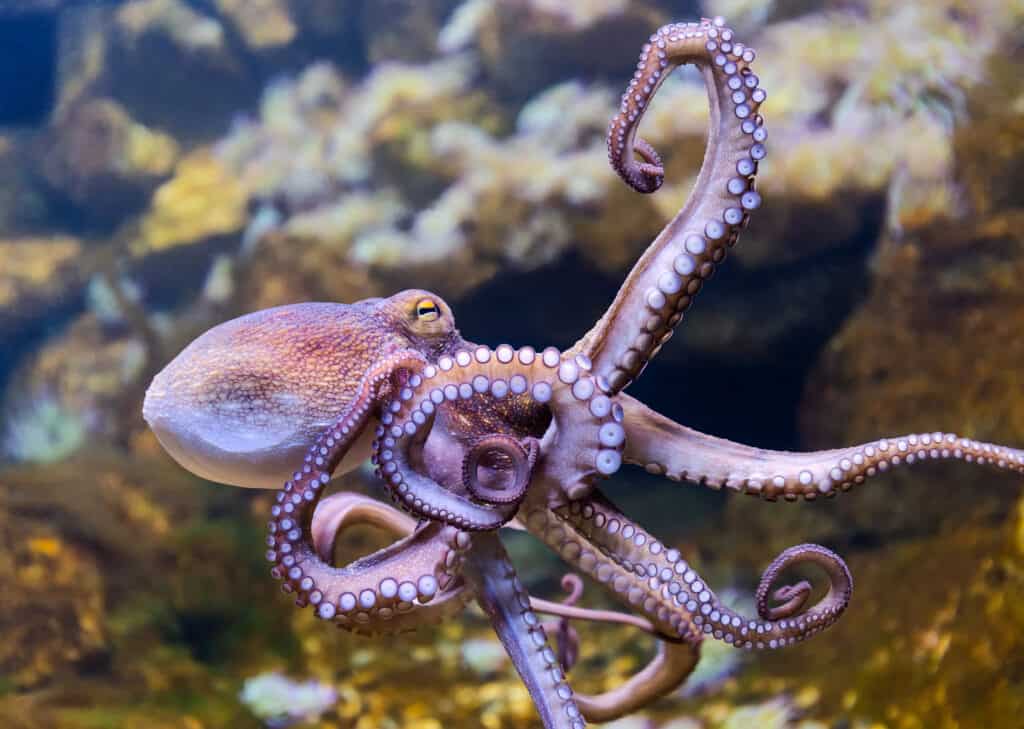Continue reading for our analysis...

In this stunning clip, we see cephalopods and fish compete for the same prey – namely crabs. At first, we meet the common octopus who is truly a master of disguise! It blends into the rocks and seabed perfectly, allowing it to stalk a group of unsuspecting crabs. To give the crabs credit, they are extraordinarily nimble and can leap from rock to rock and sprint across the shallows to get to the safer ground.
But when your enemy can move silently through the water and has multiple legs your life is always going to be dangerous! An adult octopus can eat 15 of these crabs a day so the stakes are high as the tide recedes. The crabs get just half an hour’s rest before the tide turns and the next ocean predator arrives on the scene.
This time it is the moray eel – an expert at catching crabs and armed with two rows of strong teeth to crush the shells. No crab can hide from the eel’s powerful odor-detection senses that can pick up tiny traces of chemicals in the water. Realizing that the rock that they are sitting on will soon be underwater, the crabs have to make a run for it! That is when the eel strikes and secures a meal. Click below to see this extraordinary footage filmed at a shore in Brazil.
What Do Common Octopuses Normally Eat?

Octopuses eat crustaceans, bivalves, and gastropods.
©Henner Damke/Shutterstock.com
The common octopus (Octopus vulgaris) is found in tropical, sub-tropical, and temperate waters where it inhabits mainly coastal waters and upper continental shelves. They can grow to around three feet in length and have eight arms lined with suckers. The staggering fact about octopuses is that they can learn! These guys have noticed that crabs need to take a few risks as the tide is receding. They know exactly where to lurk to bag themselves a meal and can change their skin color and texture to blend in. They typically feed on crustaceans, bivalves, and gastropods. Also, they leave the shells of their prey just outside their lairs in piles called middens!
What Do Moray Eels Normally Eat?

Moray eels eat sea snakes, fish, crustaceans, and octopuses.
©Kaschibo/Shutterstock.com
Moray eels are members of the Muraenidae family of fish (there are more than 200 different types) and have long scaleless bodies. They are found in oceans all over the world and can inhabit both coastal and deep waters. These fish can grow to 13 feet in length! To maintain that large body, they eat fish, sea snakes, crustaceans, and even octopuses! Perhaps that’s why the octopuses make themselves scarce as the tide comes in!
How Large are Octopuses vs. Moray Eels vs. the Crabs They Eat?

The flecked box crab typically measures 3 to 4 inches wide (8-10cm).
The size of crabs eaten by both octopuses and moray eels varies, depending on the size of the predators in question. For example, smaller octopuses feed on smaller shore crabs or hermit crabs, while larger octopuses consume larger species like Dungeness or blue crabs. A typical Dungeness crab measures 6” to 7” wide, but can reach 10.” The most common crab species in Brazil, where the video footage was captured, is the flecked box crab, whose average length is 3” to 4”.
On average, the common octopus’s main body (mantle) has a length of 12 to 36 inches, with arm spans 3 or 4 times the mantle length. The largest species, the Pacific octopus, has a mantle length up to 3 feet and an arm span of 20 feet or more.
Moray eels vary in length from less than a foot long to over six feet long. They will consume crabs relative to their size, with smaller eels seeking out smaller crabs, while bigger eels will go for larger prey.
Thank you for reading! Have some feedback for us? Contact the AZ Animals editorial team.







